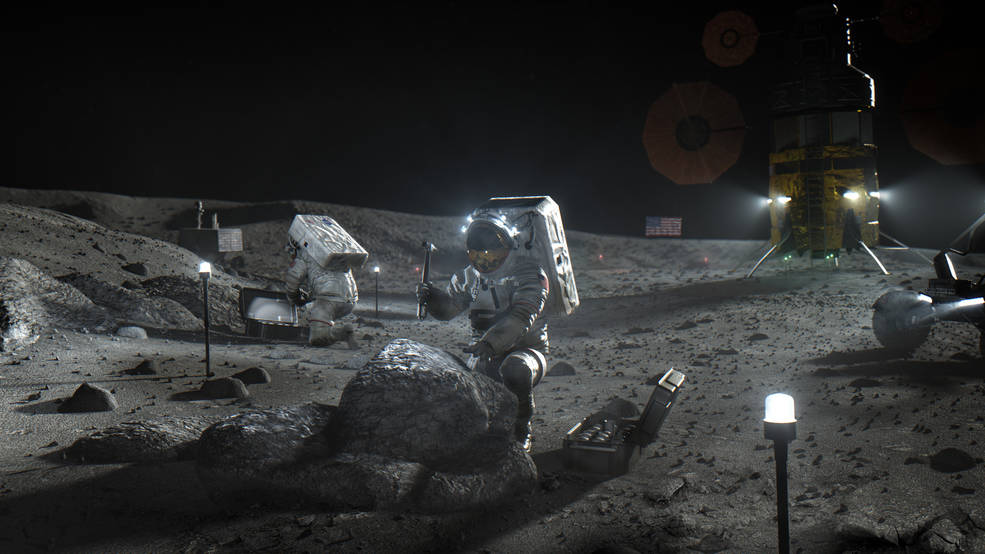
It’s been nearly half a century since the U.S. had a spacecraft capable of landing human beings on the moon. As of today, it has not one, but three—if everything goes right.
NASA officials announced on April 30, in a teleconference with space-industry leaders, the three finalists it has chosen to build the 21st century version of the Apollo-era’s well loved lunar excursion module (LEM), the four-legged, gold-foil, so-ugly-it-was-beautiful machine that landed six crews on the surface of the moon from 1969 to 1972. Unlike the LEM, which was effectively designed by NASA and then built to order by the Grumman corporation, the new landers are being designed entirely by private companies, which will then compete to prove to NASA that theirs is the ship the agency should pick.
The company names were announced alphabetically at the teleconference, but the first one called out—Blue Origin, of Kent, Washington, founded and owned by Amazon boss Jeff Bezos—might be the best bet for success anyway. Blue Origin is working with three other companies (Northrop Grumman, Lockheed Martin and Draper) to design a two-stage lander similar to the LEM. The LEM landed on the moon in a single piece and the astronauts then blasted back off in just the vehicle’s upper portion, using the bottom half as a sort of launch platform.
The second company, Dynetics, of Huntsville, Alabama, is proposing to simplify things, building a one-stage vehicle that will land in a single piece and take back off that way. The third contender, SpaceX, headquartered in Hawthorne, California, submitted the most audacious proposal: its much-touted, 50-meter (160-foot) tall, 100-passenger Starship spacecraft, which it would launch atop its own 68-meter (223-foot) tall Falcon Super Heavy rocket. Once at the moon, the Starship would land and take off in a single piece using its own set of engines.
“We want to be a customer,” NASA Administrator Jim Bridenstine said on the teleconference, stressing that the responsibility for designing the hardware and delivering the goods lies with the finalists. “We want to drive down the costs and increase access to space. This little agency is moving forward.”
But the little agency needs a lot of money. For the Trump Administration to reach its target of having astronauts back on the moon by 2024, NASA will need a funding boost of $3 billion—to $25 billion total—in 2022, with additional bumps that bring it up to $26 billion and $27 billion in 2023 and 2024, respectively. That’s a big ask given years of flat funding for the U.S. space program, but NASA is hoping to benefit from Congress opening its wallets to help keep the economy afloat during coronavirus pandemic. Without that money, NASA will be unable to fund the lunar lander, or the Orion crew vehicle and the Space Launch System—the modern-day version of the Apollo orbiter and the Saturn V rocket—that will also be necessary to bring humans to the moon.
What’s more, NASA may wind up needing money to pay for the services of more than one of the three contending lander groups. Over the course of the next 10 months, the teams will be refining their plans, and, in the process, pitching their wares, with an eye toward February of 2021, when NASA will choose a winner. But the ostensible losers may eventually fly anyway. NASA is stressing both speed—getting to the moon by 2024—and sustainability, going there to stay, rather than making the brief Apollo-style visits that have since been disparagingly dubbed the “flags and footprints” model. In the same way NASA will be paying both SpaceX and Boeing to ferry crews to and from the International Space Station, so too it might pay for the services of a company that is not chosen to build the lunar lander, but goes on to develop its own moon capability anyway.
More Must-Reads from TIME
- Cybersecurity Experts Are Sounding the Alarm on DOGE
- Meet the 2025 Women of the Year
- The Harsh Truth About Disability Inclusion
- Why Do More Young Adults Have Cancer?
- Colman Domingo Leads With Radical Love
- How to Get Better at Doing Things Alone
- Michelle Zauner Stares Down the Darkness
Write to Jeffrey Kluger at jeffrey.kluger@time.com